Winter Fun: Running and Gunning Wisconsin Raccoons
Patrick Durkin 01.30.14
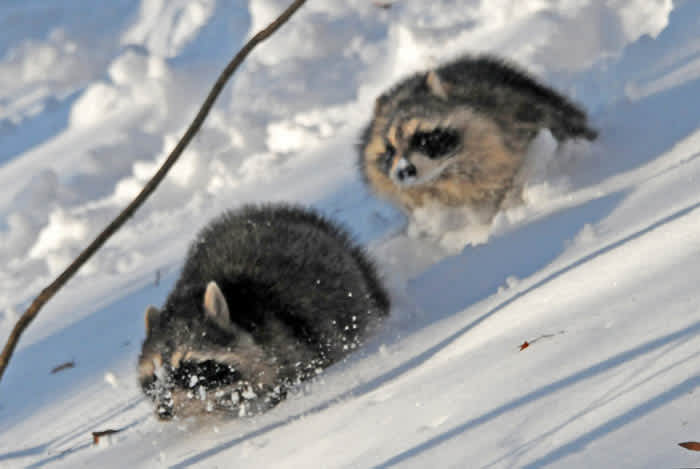
When boar raccoons square off in mating-season battles each winter, their roars, growls, and hisses could chase Hell’s demons from the woods.
But to other raccoons, brawling boars must sound like can’t-miss TV, judging by how fast they scurry from warm dens in old trees on cold winter days to watch or join a fight. And that eagerness can be their downfall when fight sounds are actually recorded ’coon calls played by hunters like Craig Polensky.
Polensky, 44, has hunted and trapped woodlots near his home in southeastern Wisconsin all of his life, restricting much of his activities to December, January, and February when he has the woods to himself. Once deer season ends each fall, properties closed to him for gun- and bowhunting open up as farmers and landowners welcome him to reduce raccoon populations.
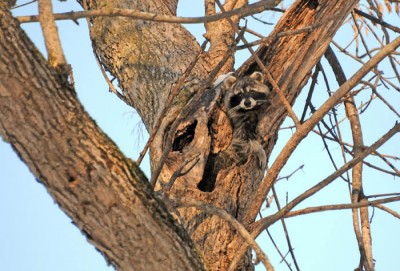
In turn, Polensky skins and dries these prime pelts for sale, and shares the meat with friends or pastors in Milwaukee to help feed homeless people and others in need.
Although trappers commonly work woodlots for raccoons each fall and winter, most hunters overlook raccoons unless they hunt the masked, ring-tailed marauders at night when they’re most active.
Polensky started hunting them in daylight several years ago after buying a video by David and Mike Sells of Iowa: Cold Weather Daytime Raccoon Calling. The Sells’ raccoon-calling expertise is well-known among trappers and fur-trade folks, but most varmint hunters overlook the tactic while focusing on fox and coyotes.
“As far as I know, daytime raccoon calling started with Mike Sells, and their video gives lots of good tips,” Polensky said. “But you still have to get out there and learn from your own mistakes to get good at it.”
As I learned when hunting with Polensky in late December, daytime calling doesn’t guarantee success, however. We hiked through snow into three distant woodlots, only to find futility from midmorning until noon. Then we hiked into a fourth woodlot and found a “hot” den tree behind a nearby barn.
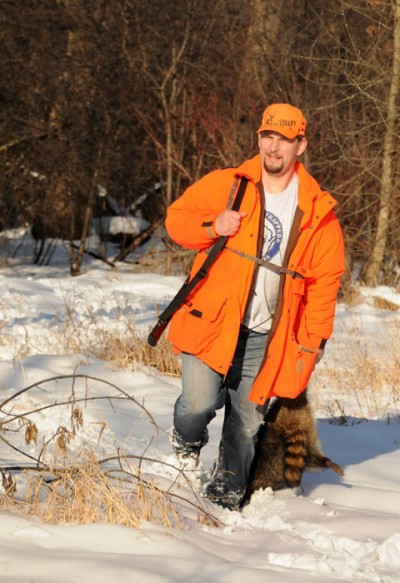
A well-worn raccoon trail snaked through the snow from the old barn, ending just yards inside the woods at the foot of a large oak. Raccoon traffic up and down the oak had flaked bark from its trunk, indicating they were denning inside the tree’s cavity. Even better, a hole 20 feet up the tree looked plenty large to accommodate raccoons.
Better yet, no snow caked the hole’s entrance.
“No snow means they’ve been going in and out of the hole,” Polensky said. “When I find a den hole two or three days after it snows, and there’s snow around the hole, I don’t bother calling. If a coon’s in there, it’s not coming out.”
This tree had everything Polensky liked for pinpointing raccoons: an active trail at its base, a barked tree trunk, and a large den hole with signs of recent activity. “Raccoons can fit into pretty small holes, but the bigger the hole, the better the chances a big coon is using it,” Polensky said. “They average about 10 pounds, but the biggest one I’ve shot weighed 35 pounds.”
He eyed the oak again and noted two other good traits. “The hole’s facing south, and the tree’s still alive,” he said.
Why’s that important?
“The most active den holes in winter face south, into the sun,” Polensky said. “That helps coons stay warm. Plus, living wood is more dense. It blocks wind and holds heat better than dead wood. Wind whistles right through dead wood.”
With that, he placed his electronic caller about five yards away on the opposite side of the tree from the den hole. It’s important not to place the caller where raccoons can see it from their den hole. They precisely pinpoint sound sources, and if they see nothing but a suspicious-looking plastic box, they’ll never come out.
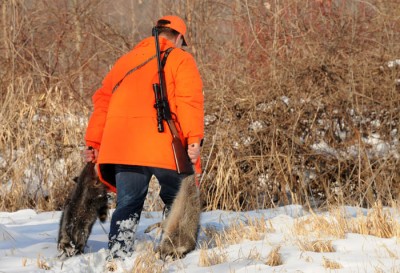
Polensky then decided where we should set up. He believes raccoons easily detect human scent, so we walked about 15 yards downwind from the oak and found trees about 10 yards apart to stand behind. We wore blaze-orange coats and hats that day because Wisconsin’s holiday deer season in the state’s chronic wasting disease zone was underway. We assumed the raccoons wouldn’t notice our orange garb. Their retinas contain only one type of cone, which basically renders them color-blind.
Polensky advised me to keep my camera poised to shoot as he did the same with his .22 Magnum lever-action rifle. He then pressed a button on his remote-control fob to activate the caller. Even though I’d heard the raccoon caterwaul three times before, I jumped at the sound.
For the first time that day, a raccoon burst from the hole. I snapped photos as Polensky fired and cleanly killed the coon, which plopped into the snow.
I was about to congratulate him when a second raccoon popped from the hole and scrambled down the trunk. A third followed closely behind. They hit the ground running, and bounded through the snow toward Polensky. That was the last mistake they made.
“That’s the first triple I’ve ever gotten on raccoons,” he said while inspecting their pelts. Raccoon fur hits its prime in early winter when thick and full to thwart the cold. Raccoons that den inside a barn’s hayloft carry the best pelts, Polensky explained, because they aren’t constantly rubbing across hard, rough edges. Tree dwellers typically show more wear, but their pelts usually aren’t well-worn until February.
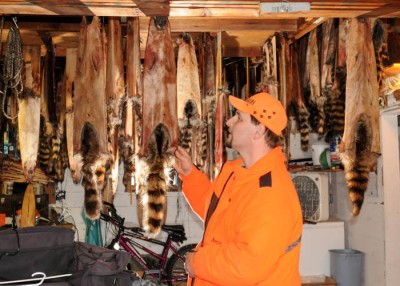
He expects to receive $20 to $40 for these pelts, but it depends on what the fur market dictates in the months ahead.
With that, he slung his rifle over his shoulder, grabbed the largest coon with one hand and the smaller two with the other, and started walking toward his truck. About 100 yards later he paused and offered another piece of advice:
“Don’t forget to bring a little plastic sled this time of year,” he said. “These things get heavy, especially when you’re walking through a foot of snow.”

